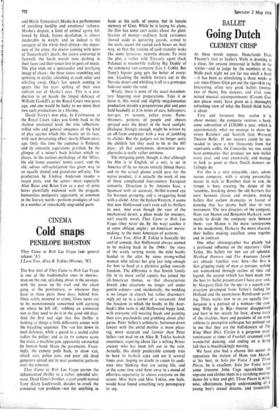Going Dutch
BALLET CLEMENT CRISP
As these words appear, Necterlands Dans Theater's visit to Sadler's Wells is drawing to a close; for anyone interested in ballet in the
'sixties—and to judge by the numbers at the Wells each night we are far too small a band
—it has been as stimulating a three weeks as any since Elinor Glyn got out the tiger-skin rug. Interesting, often very good, ballets (twenty- two of them), fine dancers, and vital, com- mitted musical accompaniments (Covent Gar- den please note), have given us a thoroughly refreshing view of what the Dutch think ballet is about.
First and foremost they realise it is about money; the company receives a hand- some subvention of f 150,000 a year, which is approximately what we manage to share be- tween Rambert and Scottish (late Western) Theatre Ballet. If our masters could be per- suaded to spare a few thousands from that supersonic coffin, the Concorde, we, too, could have -companies that produce ten new ballets every year, and tour extensively, and manage to look as good as these Dutch dancers un- failingly do.
For this is a very enjoyable, alert, adven- turous company, with a strong personality; nearer in style to Rambert than to STB, the troupe is busy creating the dance of the 'seventies, breaking down the old barriers that exist between classic and modern, making ballets that eschew dramatics in favour of dancing that has drama built into its very movement. The two directors of the company, Hans van Manen and Benjamin Harkavy; seem neatly to divide the company' style betsveen them: van Manen is the more venturesome in his modernism, Harkavy the more classical, their ballets making excellent sense together and in contrast.
One other choreographer has plainly had a profound influence on the repertory : Glen Tetley. His ballets for NOT are all splendid; Mythical Hunters and The Anatomy Lesson are already familiar over here—the first is that gripping study of man as pursuer, seeking out womankind through realms of time and legend; the second (which has been made into the best Tv ballet presentation I have ever seen, by Margaret Dale for the sec) is a superb con- struction developed from Tetley's feeling for Holland and the eponymous Rembrandt paint- ing. Three works new to us are equally fine: Sargasso is a portrait of a woman—the stun- sling Willy de la Bije—forever disappointed and hurt in her search for love; Arena treats of the rivalries, fears and passions of six male athletes (a perceptive colleague has pointed out to me that they are the bull-dancers of The King Must Die); Circles is a gorgeous octet, reminiscent at times of Freefall, crammed with wonderful dancing, and ending on a dying fall that is breathtakingly moving. We have also had a chance this season to appreciate the stature of Hans van -Mane% at his best, in Solo for Voice I and Three Pieces, he is excellent. Solo. for Voice takes some tiresome John Cage squawking: for soprano and clothes them in a ravishing mating- dance for a boy and girl; Three Pieces is Witty, wise, affectionate, hugely understanding of a young boy's sexual dreams, and irresistible. The contrast between van When's style in all his works and Harkavy's more academic manner is very pertinent, and reveals how well the Dutch dancers can encompass both entrechats and contractions a la Graham. Like van Manen's pieces, Harkavy's are well made, and in a ballet to Bach music (which notori- ously brings out the worst in choreographers) he dares and wins in a most enjoyable way.
My only complaint about the season is that the ballets often look dr6ry; oh for a 134rard to match wit and simplicity. The only dis- cernible influence on Dutch designing seems to be those foolish corset advertisements that clutter the escalators on the Underground; the result is a visual anaemia that is directly counter to the dancing and the ballets, which are full of life.
A final note about two arrivals at Covent Garden; the first was Stuttgart's premier danseur, Richard Cragun, partnering Dame Margot Fonteyn in a Swan Lake in which she was glorious, and he not less so; the second, Geoffrey Cauley's In the Beginning, already noted with great pleasure in these columns, and seeming even better at a second viewing.



































 Previous page
Previous page